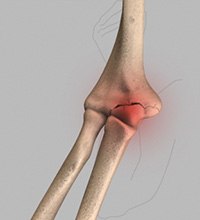Elbow Fracture

Three bones, the humerus, radius and ulna, make up the elbow joint. An elbow fracture is a break in one of the bones that make up the elbow joint. The types of elbow fractures include:
- Radial head and neck fractures: Fractures in the head portion of the radius bone
- Olecranon fractures: Most common elbow fractures, occurring at the bony prominence of the ulna
- Distal humerus fractures: Common fractures in children and the elderly. Nerves and arteries in the joint may sometimes be injured.
An elbow fracture may occur from trauma, a fall on an outstretched arm, direct blow to the elbow or abnormal twist to the joint beyond its functional limit.
The symptoms of an elbow fracture include pain, bruising, stiffness, swelling in and around the elbow, a popping or cracking sound, numbness or weakness in the arm, wrist and hand, and deformity of the elbow bones.
To diagnose an elbow fracture, X-rays of the joint are ordered. In some cases, a CT scan may be needed to view the details of the joint surface.
The aim of treatment is to maximise early motion and reduce the risk of stiffness. Nonsurgical treatment options include pain medication, ice application, the use of a splint or a sling to immobilise the elbow during the healing process and physiotherapy. Surgery is indicated in displaced and open fractures to realign the bones and stabilise the joint with screws, plates, pins and wires. Strengthening exercises are recommended to improve the range-of-motion.













